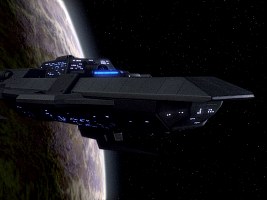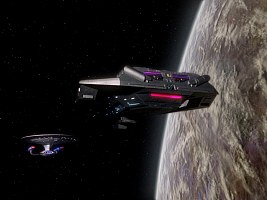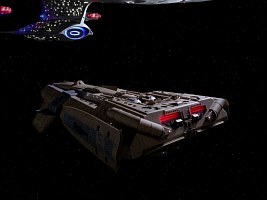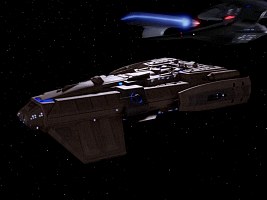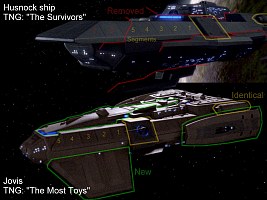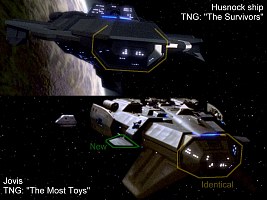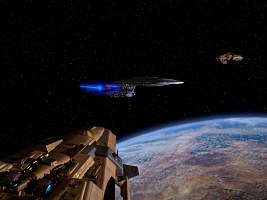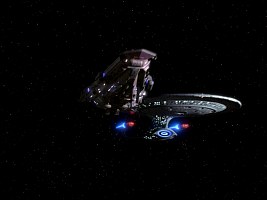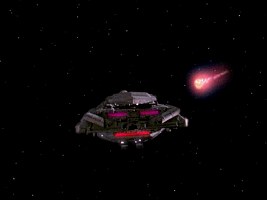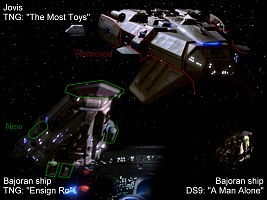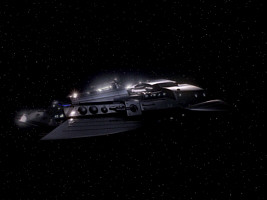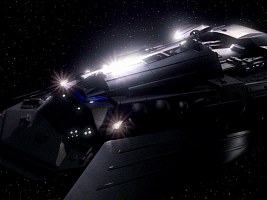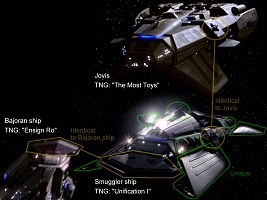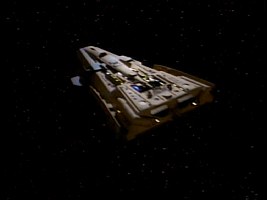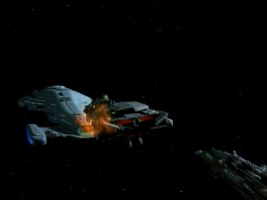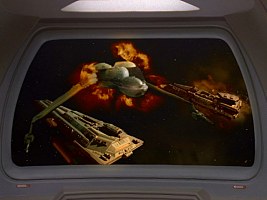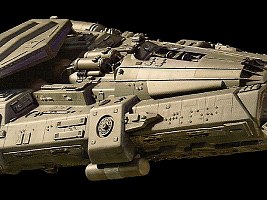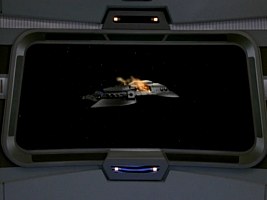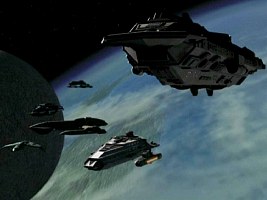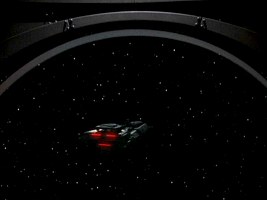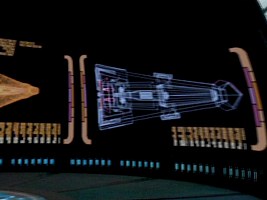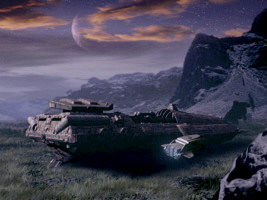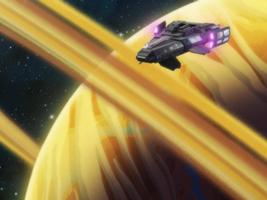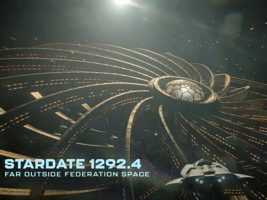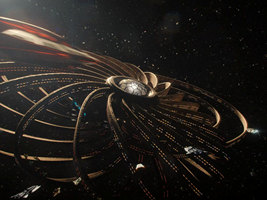Redresses of the Husnock Ship
by Jörg Hillebrand, Alice Orbán and Bernd Schneider
The ship model with the arguably most reuses in different roles and of different civilizations began its life as the Husnock ship in TNG: "The Survivors". It was subsequently modified several times and appeared most notably as the Jovis in TNG: "The Most Toys", the smuggler ship in TNG: "Unification I" and a Bajoran "hammerhead" freighter on DS9. The latter incarnation of the model was even turned into a CG model, which could be seen out of place in the Delta Quadrant and out of time in the 22nd century. Overall, variations of this model appeared in no less than twenty-four Star Trek episodes of six series:
1. Husnock ship (TNG: "The Survivors")
2. Zibalian freighter Jovis (TNG: "The Most Toys")
3. Kaelon warship (TNG: "Half a Life")
4. Bajoran cruiser, Antares class (TNG: "Ensign Ro")
5. Boreal III freighter Kallisko (TNG: "Silicon Avatar")
6. Smuggler ship (TNG: "Unification I")
7. Valtese ship (TNG: "The Perfect Mate")
8. Bajoran transport (DS9: "A Man Alone")
9. Kressari freighter Calondon (DS9: "The Circle")
10. Bajoran transport (DS9: "Shadowplay")
11. Bajoran transport (DS9: "The Collaborator")
12. Numiri standard patrol sip (VOY: "Ex Post Facto")
13. Cardassian transport (DS9: "Rules of Engagement")
14. Ilari warship (VOY: "Warlord")
15. Bajoran transport (DS9: "The Reckoning")
16. Bajoran transport, part of Derna blockade, CGI (DS9: "Shadows and Symbols")
17. Bajoran transport (DS9: "Take Me Out to the Holosuite")
18. Antarian transstellar rally spectator ship, CGI (VOY: "Drive")
19. Nuu'Bari freighter, CGI (VOY: "Flesh and Blood II")
20. Ship in the Void, CGI (VOY: "The Void")
21. Kantare supply ship, CGI (ENT: "Oasis")
22. Xantoras evacuation ship, CGI (ENT: "The Breach")
23. Collector ship, animated (LOW: "Dos Cerritos")
24. Ships or shuttles, CGI ("Section 31")
 No differences exist between the composition of the original shots and the ones in TNG-R. The latter still use the same takes of the physical model.
No differences exist between the composition of the original shots and the ones in TNG-R. The latter still use the same takes of the physical model.
The following section investigates all variations of the original Husnock ship miniature, in production order.
Analysis
Husnock ship
 The Husnock ship in TNG: "The Survivors" is actually only an illusion created by Kevin Uxbridge, but there is reason to believe that the vessel that attacked the planet Delta Rana IV really looked like that. The fake ship first appears without the spike on the bottom. The second and third time it shows up the spike is present. We may assume that on the real ship the spike is extractable, or that Kevin Uxbridge added the spike for a greater dramatic impact. In any case this small modification is irrelevant for the further investigation. The model is overall very angular and the surface is mostly even. The hull color is all silver-gray. The model was built by Tony Meininger and not by regular TNG model vendor Greg Jein, as Jein was working on "The Hunt for Red October" and "Star Trek V" at the time the episode was being prepared (2nd half of 1989).
The Husnock ship in TNG: "The Survivors" is actually only an illusion created by Kevin Uxbridge, but there is reason to believe that the vessel that attacked the planet Delta Rana IV really looked like that. The fake ship first appears without the spike on the bottom. The second and third time it shows up the spike is present. We may assume that on the real ship the spike is extractable, or that Kevin Uxbridge added the spike for a greater dramatic impact. In any case this small modification is irrelevant for the further investigation. The model is overall very angular and the surface is mostly even. The hull color is all silver-gray. The model was built by Tony Meininger and not by regular TNG model vendor Greg Jein, as Jein was working on "The Hunt for Red October" and "Star Trek V" at the time the episode was being prepared (2nd half of 1989).
The conical shape of the Husnock ship is a bit obscured owing to the camera angles, and because of several add-ons, most notably the tall superstructure and the weapons platforms on port and starboard. We can see the ship from various angles in the episode, including a side and a rear view.
This is the last time we see the Husnock miniature in a Star Trek episode. The model was extensively modified after "The Survivors".
Jovis
 The Jovis is Kivas Fajo's Zibalian freighter and can be seen on various occasions in TNG: "The Most Toys". It is not immediately evident, but the ship is a modification of the Husnock ship. The model retains the conical overall shape, which is even better recognizable on the Jovis because there are overall fewer and smaller superstructures, and because the model is filmed more from above than the Husnock ship (perhaps to let it appear less menacing). The hull color is bright brown/ochre, with some details being bluish. This modification, and all subsequent ones, were done in Greg Jein's workshop.
The Jovis is Kivas Fajo's Zibalian freighter and can be seen on various occasions in TNG: "The Most Toys". It is not immediately evident, but the ship is a modification of the Husnock ship. The model retains the conical overall shape, which is even better recognizable on the Jovis because there are overall fewer and smaller superstructures, and because the model is filmed more from above than the Husnock ship (perhaps to let it appear less menacing). The hull color is bright brown/ochre, with some details being bluish. This modification, and all subsequent ones, were done in Greg Jein's workshop.
Comparing the aft sections of the Husnock ship and the Jovis, we can see that the central portion is identical, including the engine locations and the characteristic tubes that run around the hull corners. Only the lighting was changed for the Jovis. The two upper exhausts were violet on the Husnock ship, whereas they are red on the Jovis. The engine color will remain consistent on the future appearances of the Jovis miniature, except for "The Circle" where these spots are dark. The wings that used to hold the weapons on the Husnock ship were cut off. Instead of the wings we can see two vertical fins on the Jovis that are likely supposed to be the ship's warp engines. The lower spike of the Husnock ship was removed as well (it must have been detachable anyway).
As we compare the side views, they are very different at the first glance. But we can make out several common features. Besides the aforementioned tubes that wrap around the rear end, we can see a raised lateral hull panel with a bluish color that seems to hold the weapons of the Jovis. This panel is already present on the Husnock vessel. Only the gun barrel itself and its base were added on the Jovis. The most notable additions to the Jovis are the already mentioned fins on the rear end, and the wings on the bow. Conversely, the major portion of the superstructure of the Husnock ship was removed, as well as a part of the outer hull segments. On the Husnock ship we can recognize seven hull segments in front of the protruding hull part, of which two and a half were "peeled off". The now exposed recessed front tip of the Jovis was blended into a sloped and curved dorsal hull part. This "engine hood" will be enlarged and illuminated on the later incarnations of the miniature. Overall, the Jovis miniature is only bit shorter than the Husnock version despite the missing panels, and still has essentially the same proportions.
The front view comparison of the two vessels reveals that the front tip with its roughly octagonal cross-section, as it is visible on the Jovis due to the missing hull panels, may already have existed on the Husnock version of the miniature. At least the lower portion of the section seems to be identical. We can also see that two smaller wings were attached to the already mentioned protruding panels on port and starboard where the weapons of the Jovis are likely located.
Kaelon warship
 Two Kaelon warships appear in TNG: "Half a Life". The ship miniature is the same as Kivas Fajo's vessel Jovis in TNG: "The Most Toys", without modifications. If we presuppose that the Kaelon military is not very advanced, we may believe that the real designs are identical too. Yet, new shots were filmed for "Half a Life", and here the ship is lighted somewhat differently than in its original appearance in "The Most Toys" and in the various re-uses of this footage still to come. The Kaelon ships look darker, and the fan-like opening from which the weapons protrude is green instead of blue.
Two Kaelon warships appear in TNG: "Half a Life". The ship miniature is the same as Kivas Fajo's vessel Jovis in TNG: "The Most Toys", without modifications. If we presuppose that the Kaelon military is not very advanced, we may believe that the real designs are identical too. Yet, new shots were filmed for "Half a Life", and here the ship is lighted somewhat differently than in its original appearance in "The Most Toys" and in the various re-uses of this footage still to come. The Kaelon ships look darker, and the fan-like opening from which the weapons protrude is green instead of blue.
After this appearance the miniature was modified again. All further appearances of the Jovis configuration are stock footage.
Bajoran transport (TNG: "Ensign Ro")
 The Bajoran freighter of the "Antares class" shows up in several episodes, beginning with TNG: "Ensign Ro". The model is another modification of the Jovis and hence of the original Husnock configuration. Most notably a hammerhead-shaped front tip was added, and a hexagonal pod above the engine section near the rear end, among other changes. The Starship Database - Bajoran Ship Classes refers to this variation of the model as "unknown type 2" (although the model predates the similarly shaped "unknown type 1"). The Bajoran modification of the former Jovis is brown, rather than ochre.
The Bajoran freighter of the "Antares class" shows up in several episodes, beginning with TNG: "Ensign Ro". The model is another modification of the Jovis and hence of the original Husnock configuration. Most notably a hammerhead-shaped front tip was added, and a hexagonal pod above the engine section near the rear end, among other changes. The Starship Database - Bajoran Ship Classes refers to this variation of the model as "unknown type 2" (although the model predates the similarly shaped "unknown type 1"). The Bajoran modification of the former Jovis is brown, rather than ochre.
Note We have not yet corrected the Fact Files drawing of this version of the miniature (and of the Numiri ship likewise). Most likely the protruding hull panel needs to be moved back, just as well as the "engine hood".
We can see that the rear views of the Jovis and of the Bajoran ship are still largely identical. The tubes running around the corners of the rear end are still present, and the upper engines are the same as well. They are lighted pink in TNG: "Ensign Ro", a color that will be switched to red for the appearances in DS9. The fins of the Jovis are gone on the Bajoran variant of the model. The most notable addition to the rear end of the model is the roughly hexagonal pod. We can also see that two small angular pods were added to the bottom of the ship. Furthermore four round bumps were attached to the bottom. Overall, the Bajoran version seems to have more hull greebles, which may have been added on purpose, to insinuate that the ship type is rather primitive.
More differences become evident as we look at the front views. Most notably the Bajoran ship sports the characteristic "hammerhead" that was added to the existing bow of the Jovis, probably without cutting off anything. Conversely, the wings were cut off from the bow section. Looking side by side at the modifications that were made to the aft end and to the forward end, we can see where the new hexagonal pod comes from: It consists of the two former front wings that were simply glued together! The two trapezoid wings give us one hexagonal pod. The two ribs of the wings are still visible on top of the pod on the top view of the studio model.
The small wings on the raised mid-ship hull section were removed too. The Bajoran version features tanks in the place of the small wings. As we never see a top view of the Bajoran miniature, it is not clear whether the protruding weapons of the Jovis are still present. They are still on the smuggler ship, the next incarnation, but not any longer on the Numiri patrol vessel. The latter is otherwise largely identical to the Bajoran ship.
Kallisko
The Boreal III freighter Kallisko appears in TNG: "Silicon Avatar". The Kallisko is identical to the Jovis and all shots are stock footage from TNG: "The Most Toys".
Smuggler ship
 In TNG: "Unification I", the Enterprise-D encounters the unidentified smuggler vessel at the Qualor II Surplus Depot (and that explodes after taking just one hit). Whereas several wing-like add-ons obscure the shape of the vessel's main body, it is clearly another modification of the Husnock/Jovis/Bajoran miniature. The smuggler ship may have been created in a way that the additions could be removed and the model returned to its Bajoran configuration, because new shots of the latter still appear after "Unification I". The color of this variant of the ship is plain dark gray or black.
In TNG: "Unification I", the Enterprise-D encounters the unidentified smuggler vessel at the Qualor II Surplus Depot (and that explodes after taking just one hit). Whereas several wing-like add-ons obscure the shape of the vessel's main body, it is clearly another modification of the Husnock/Jovis/Bajoran miniature. The smuggler ship may have been created in a way that the additions could be removed and the model returned to its Bajoran configuration, because new shots of the latter still appear after "Unification I". The color of this variant of the ship is plain dark gray or black.
The smuggler ship appears to be very "flat", as if the bottom had been removed. But this impression may be created by the wings, which obscure much of the bottom half. On the HD side views we can see the lights in the still existing lower hull part and can tell them apart from the star background.
We can compare the smuggler ship to its previous two configurations (Jovis and Bajoran) to confirm that it is really essentially the same model. We never get to the see the dorsal side of the Bajoran version, neither in TNG nor in DS9, so the comparison with the Jovis is useful. Interestingly, the weapons of the Jovis can still be seen in the raised lateral hull panels of the smuggler ship. On the other hand, it has the hammerhead front tip of the Bajoran freighter. In light of this evidence it is possible that the smuggler ship was indeed built after the modifications to the Bajoran version had taken place. The smuggler version sports several extensions. The wings look like they are easily detachable, making it possible to return the model to its previous (Bajoran) state - in order to serve as the Numiri patrol ship and the Cardassian version of the design. Furthermore, there are a couple of "balls" protruding from the hull, which may be removed easily just as well.
Another difference to the Jovis is that the smuggler ship has a much taller (and lighted) "engine hood". This feature is not recognizable on the Bajoran model, but we can see that the corresponding section on the Numiri ship is identical. The photo of the studio model clearly shows the raised engine hood too, as well as the dark color of the model in its later configuration as the Numiri vessel. It is not clear whether, after the model was painted black or dark gray to act as the smuggler vessel, it always remained this color, or whether its was returned to gray to become eventually black again.
Valtese ship
The Valtese ship appears in TNG: "The Perfect Mate". It is identical to the Jovis and all shots are stock footage from TNG: "The Most Toys".
Bajoran transport (DS9: "A Man Alone")
The ship that appears on an upper docking pylon of Deep Space 9 in DS9: "A Man Alone" has the same configuration as in TNG: "Ensign Ro". We can see two new shots that are not lifted from "Ensign Ro", one rear view and one front/bottom view. As already mentioned, we are not sure whether the ship was still black at the time (in which case it would have required digital recoloring) or whether it was painted brown again.
The footage from DS9: "A Man Alone" appears in several more DS9 episodes. All other shots of the ship type (in the DS9 season 7 episode "Shadows and Symbols", in Voyager and Enterprise) actually show a CG model.
Kressari freighter
 The Kressari freighter appears in DS9: "The Circle". It is identical to the Jovis and all shots are stock footage from TNG: "The Most Toys". However, the engines are dark on the Kressari freighter and not red as on the Jovis. This is not an oversight but has a quite simple reason: The Kressari freighter is flying backward, and we are looking at the front end and not at the rear end! Whether we believe that the Kressari have modified this common vessel type to fly backward or whether it is an entirely different type of vessel is probably a matter of taste. Most likely the flight direction will not be "fixed" in a possible remastered version of the DS9 episode.
The Kressari freighter appears in DS9: "The Circle". It is identical to the Jovis and all shots are stock footage from TNG: "The Most Toys". However, the engines are dark on the Kressari freighter and not red as on the Jovis. This is not an oversight but has a quite simple reason: The Kressari freighter is flying backward, and we are looking at the front end and not at the rear end! Whether we believe that the Kressari have modified this common vessel type to fly backward or whether it is an entirely different type of vessel is probably a matter of taste. Most likely the flight direction will not be "fixed" in a possible remastered version of the DS9 episode.
Bajoran transport (DS9: "Shadowplay")
This episode only shows stock footage from DS9: "A Man Alone".
Bajoran transport (DS9: "The Collaborator")
This episode only shows stock footage from DS9: "A Man Alone".
Numiri patrol sip
 The Numiri ship seen in VOY: "Ex Post Facto" has the same configuration as the Bajoran transport. Only the color was switched from brown to dark gray. Actually, the Numiri model is much like a reconstruction of the Bajoran configuration, after it had been modified to the smuggler ship for "Unification I". We can't be certain whether the Bajoran ship and the Numiri vessel are otherwise really identical, considering that top views of the first are missing. The available photo of the dark gray studio model obviously shows the Numiri version.
The Numiri ship seen in VOY: "Ex Post Facto" has the same configuration as the Bajoran transport. Only the color was switched from brown to dark gray. Actually, the Numiri model is much like a reconstruction of the Bajoran configuration, after it had been modified to the smuggler ship for "Unification I". We can't be certain whether the Bajoran ship and the Numiri vessel are otherwise really identical, considering that top views of the first are missing. The available photo of the dark gray studio model obviously shows the Numiri version.
As far as we can tell, the model was never modified after this appearance and was used just once more, in DS9: "Rules of Engagement".
Cardassian transport
 We can see new footage of the hammerhead freighter in DS9: "Rules of Engagement". Here one ship of this type appears in a Cardassian convoy, and is likely supposed to be a Cardassian design too. The color is ochre, as it is normally used for Cardassian vessels. It is possible that the miniature was repainted yet again (it was dark gray the last time it appeared as the Numiri vessel). But most likely the ship was digitally recolored. All different ship types of the convoy have the same color, and it seems unlikely that they were all repainted when it is much easier to equalize the colors digitally.
We can see new footage of the hammerhead freighter in DS9: "Rules of Engagement". Here one ship of this type appears in a Cardassian convoy, and is likely supposed to be a Cardassian design too. The color is ochre, as it is normally used for Cardassian vessels. It is possible that the miniature was repainted yet again (it was dark gray the last time it appeared as the Numiri vessel). But most likely the ship was digitally recolored. All different ship types of the convoy have the same color, and it seems unlikely that they were all repainted when it is much easier to equalize the colors digitally.
Ilari warship
The Ilari warship in VOY: "Warlord" is identical to the smuggler ship from TNG: "Unification I", using stock footage from this episode. Only additional flames were inserted.
Bajoran transport (DS9: "The Reckoning")
This episode only shows stock footage from DS9: "A Man Alone".
Bajoran transport (DS9: "Shadows and Symbols")
 In this episode we can see the CG model of the Bajoran transport for the first time. CG models were preferred over motion control photography at the time, and in order to show the Bajoran armada at Derna it wouldn't have sufficed to use existing footage of the physical models. Hence CG designs of several different existing Bajoran studio miniatures were newly created. Besides three of the "hammerhead" freighters (type 2) that are under investigation here, we can also see the other triangular Bajoran freighter (type 1) as CG models in this episode, as well as the sub-impulse raider, the assault vessel and the Karemma vessel.
In this episode we can see the CG model of the Bajoran transport for the first time. CG models were preferred over motion control photography at the time, and in order to show the Bajoran armada at Derna it wouldn't have sufficed to use existing footage of the physical models. Hence CG designs of several different existing Bajoran studio miniatures were newly created. Besides three of the "hammerhead" freighters (type 2) that are under investigation here, we can also see the other triangular Bajoran freighter (type 1) as CG models in this episode, as well as the sub-impulse raider, the assault vessel and the Karemma vessel.
Note Speaking of the Karemma vessel, the CGI turned out only similar to the physical miniature. The CG model of the Bajoran transport (type 1) seems to be more accurate. As already mentioned, the Fact Files drawing of the miniature is likely inaccurate, so there would be no point in comparing this drawing with the CG side view.
The two Bajoran freighters (type 2 and type 1), but none of the other three Bajoran ships, were turned into CG models by Tim Wilcox at Digital Muse.
Tim Wilcox: "I was hired for roughly 4-6 weeks at Digital Muse to handle converting these two models. The technology was not where it is today to allow for detailed, practical models to be scanned on a both economic or aesthetic manner - It needed a human touch. David Stipes had brought the actual models, crated, to Muse and they both became my office mates for the next few weeks. I photographed the models to assist in both the recreation of the textures and in measuring and accurately modeling the nurnies along the respective hulls. Having the models on hand was the key though, as I constantly was using my ruler to check and double check everything as I was building it. If you look at the top 'bridge' of Freighter 1, you will see that it is a zip kick bottle [a super glue accelerator] in real life that was re-purposed into a cool bit of spaceship. All the modeling was done in Lightwave and the texturing was in Photoshop. After the hero, detailed models were finished, I also circled back and built low poly proxy version which aid tremendously in the animation process and are replaced out prior to final renders of shots."
This is the first and the last time we see the CG model of the hammerhead freighter in its role as a Bajoran ship. The CGI will be re-used nonetheless, for ships in the Delta Quadrant (VOY) and of the 22nd century (ENT).
Bajoran transport (DS9: "Take Me Out to the Holosuite")
This episode only shows stock footage from DS9: "A Man Alone".
Antarian transstellar rally spectator ship
Two "hammerhead" transports are among the spectator ships that are lined up on both sides of the racing track of the Antarian Transstellar Rally in VOY: "Drive". It is obviously the same CG model as the Bajoran transport. The episode shows more than a dozen ship and shuttle designs that don't belong into the area of the Delta Quadrant (actually, not a single new design was created for this ship-heavy episode, only two previously seen shuttles were modified), but the Bajoran hammerhead freighters are clearly a stretch. Fortunately we can spot them only in the background of the scene.
Nuu'Bari freighter
The next appearance of the (ex-)Bajoran hammerhead freighter in the Delta Quadrant is as the Nuu'Bari freighter in VOY: "Flesh and Blood II".
Ship in the Void
We can see the hammerhead CGI one more time in the Delta Quadrant, as one ship that escapes from the Void together with Voyager in VOY: "The Void". The episode also shows us a schematic top view of the ship.
Kantare supply ship
We can also see the CG model of the hammerhead in ENT: "Oasis". The vessel has crashed onto the surface of a planet many years ago and is accordingly "weathered".
Xantoras evacuation ship
We can see the CG model of the hammerhead ship for one last time in ENT: "The Breach". Here it is among the ships that evacuate aliens from the planet Xantoras whose new government is xenophobic.
Collector ship (Jovis?)

 The Collector Yorif in LOW: "Dos Cerritos" has a ship that looks much like the Jovis. The lateral engine pods and the wings are differently shaped, there is an extra pair of lateral wings, the "cannon" is gone, the angular superstructure was modified and several greebles differ. There is no reason why another Collector couldn't have a very similar ship. But with the collection room being identical to the one on the Jovis, it is the most reasonable assumption that this is the very same ship. Maybe Yorif acquired it from his colleague Kivas Fajo, who was likely sentenced to a long term in prison after killing his assistant.
The Collector Yorif in LOW: "Dos Cerritos" has a ship that looks much like the Jovis. The lateral engine pods and the wings are differently shaped, there is an extra pair of lateral wings, the "cannon" is gone, the angular superstructure was modified and several greebles differ. There is no reason why another Collector couldn't have a very similar ship. But with the collection room being identical to the one on the Jovis, it is the most reasonable assumption that this is the very same ship. Maybe Yorif acquired it from his colleague Kivas Fajo, who was likely sentenced to a long term in prison after killing his assistant.
Ship or shuttle

 Numerous small ships or shuttles can be seen around the station Baraam in "Section 31". One ship type that appears multiple times can be identified as the smuggler ship from TNG: "Unification I".
Numerous small ships or shuttles can be seen around the station Baraam in "Section 31". One ship type that appears multiple times can be identified as the smuggler ship from TNG: "Unification I".
Model casting
A casting of the studio model, consisting of a top and a bottom half, showed up at a charity auction, apparently as a donation by Greg Jein. On both parts we can see the remains of circular parts that were glued on at some point before the casting was taken. The removed add-ons are quite obviously those of the smuggler ship. It seems that, while the ship was being turned into the Bajoran version (again?), Greg Jein created some castings, not only for the auction, but also for a possible other Bajoran design (see below).
Bajoran ship type 1
As already mentioned, there is a second Bajoran ship type with a similar conical planform that can be seen in the opening credits of DS9 and also in several episodes (ship type 1). The similarity with the "hammerhead" (ship type 2) isn't a coincidence. In fact, the upper hull portion of the ship type 1 (which is chronologically the newer one, despite our numbering) is nearly identical to the lower hull portion of the ship type 2. The ship type 2 was never taken apart (although at the first glance the smuggler ship looks like it missing the lower hull part). In DS9: "Rules of Engagement" we can even see the two different models side by side, in newly filmed takes. Greg Jein is known to use the master-mold-cast technique of modelmaking, and since we already know that castings of the ship type 2 exist, it is certain that he created the upper half of type 1 from such a mold.
Summary
This table summarizes all the variants and appearances of the ship model (miniature as well as CGI):
| Ship type | Episode | Stock footage from | Modifications | Model type |
 Husnock ship |
TNG: "The Survivors" | - | - | Miniature |
 Zibalian freighter |
TNG: "The Most Toys" | - | Extensive modifications, aft wings removed and replaced with fins, front wings added, front tip cut off, superstructure removed,... | Miniature |
 Kaelon warship |
TNG: "Half a Life" | - | Different lighting | Miniature |
 Bajoran cruiser |
TNG: "Ensign Ro" | - | Additional parts, such as a hexagonal pod, front wings removed,... | Miniature |
 Boreal III freighter |
TNG: "Silicon Avatar" | "The Most Toys" | - | Miniature |
 Smuggler ship |
TNG: "Unification I" | - | Additional wings and hull greebles (that are easily removable), color change to dark gray | Miniature |
 Valtese ship |
TNG: "The Perfect Mate" | "The Most Toys" | - | Miniature |
 Bajoran transport |
DS9: "A Man Alone" | - | - | Miniature |
 Kressari freighter |
DS9: "The Circle" | "The Most Toys" | Engines dark, front and rear end switched | Miniature |
 Bajoran transport |
DS9: "Shadowplay" | "A Man Alone" | - | Miniature |
| DS9: "The Collaborator" | "A Man Alone" | - | Miniature | |
 Numiri patrol ship |
VOY: "Ex Post Facto" | - | Return to previous (Bajoran) configuration, except for the still dark gray color | Miniature |
 Cardassian transport |
DS9: "Rules of Engagement" | - | Ochre hull color | Miniature |
 Ilari warship |
VOY: "Warlord" | "Unification I" | - | Miniature |
 Bajoran transport |
DS9: "The Reckoning" | "A Man Alone" | - | Miniature |
 Bajoran transport |
DS9: "Shadows and Symbols" | - | Conversion to CG model | CGI |
 Bajoran transport |
DS9: "Take Me Out to the Holosuite" | "A Man Alone" | - | Miniature |
 Antarian rally ship |
VOY: "Drive" | - | - | CGI |
 Nuu'Bari freighter |
VOY: "Flesh and Blood II" | - | - | CGI |
 Ship in the Void |
VOY: "The Void" | - | - | CGI |
 Kantare supply ship |
ENT: "Oasis" | - | Model "weathered" | CGI |
 Xantoras evacuation ship |
ENT: "The Breach" | - | - | CGI |
 Collector ship |
LOW: "Dos Cerritos" | - | Different wings, now two pairs of wings, different engines, no cannon, different superstructure | Animated |
 Ship or shuttle |
"Section 31" | - | Essentially like ship from "Unification I" | CGI |
See Also
Analysis of the Antarian Transstellar Rally - identification of all involved ships and commentary
The Antares Class(es) - too many designs with the same name
Alpha and Beta Quadrant Ships F-K
Alpha and Beta Quadrant Ships S-Z
Alpha and Beta Quadrant Ships of Unknown Affiliation
Credits
Thanks to Rob Minnes for additional information regarding the model history and the people involved in its construction and to Brian Tait for the photos of the model castings.

Back to Starship Articles index







 Husnock ship without spike in TNG: "The Survivors"
Husnock ship without spike in TNG: "The Survivors"
